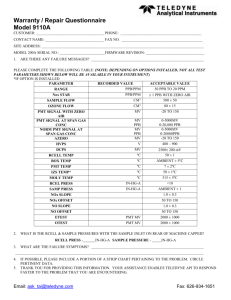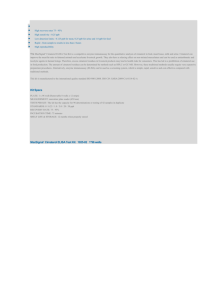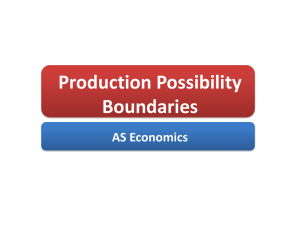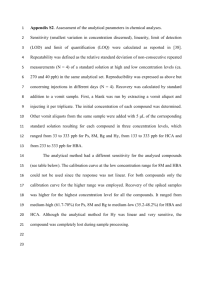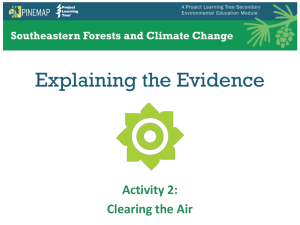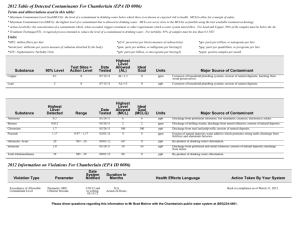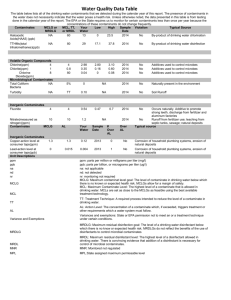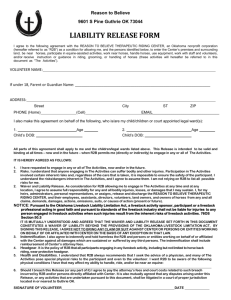CCR Simple with Table
advertisement
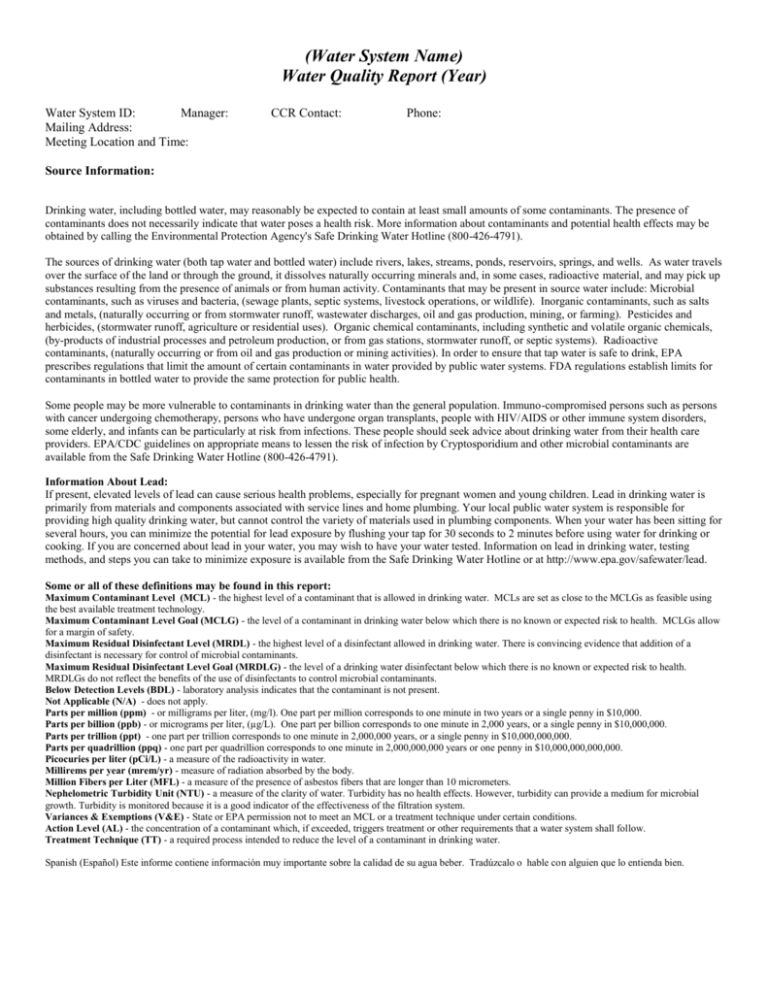
(Water System Name) Water Quality Report (Year) Water System ID: Manager: Mailing Address: Meeting Location and Time: CCR Contact: Phone: Source Information: Drinking water, including bottled water, may reasonably be expected to contain at least small amounts of some contaminants. The presence of contaminants does not necessarily indicate that water poses a health risk. More information about contaminants and potential health effects may be obtained by calling the Environmental Protection Agency's Safe Drinking Water Hotline (800-426-4791). The sources of drinking water (both tap water and bottled water) include rivers, lakes, streams, ponds, reservoirs, springs, and wells. As water travels over the surface of the land or through the ground, it dissolves naturally occurring minerals and, in some cases, radioactive material, and may pick up substances resulting from the presence of animals or from human activity. Contaminants that may be present in source water include: Microbial contaminants, such as viruses and bacteria, (sewage plants, septic systems, livestock operations, or wildlife). Inorganic contaminants, such as salts and metals, (naturally occurring or from stormwater runoff, wastewater discharges, oil and gas production, mining, or farming). Pesticides and herbicides, (stormwater runoff, agriculture or residential uses). Organic chemical contaminants, including synthetic and volatile organic chemicals, (by-products of industrial processes and petroleum production, or from gas stations, stormwater runoff, or septic systems). Radioactive contaminants, (naturally occurring or from oil and gas production or mining activities). In order to ensure that tap water is safe to drink, EPA prescribes regulations that limit the amount of certain contaminants in water provided by public water systems. FDA regulations establish limits for contaminants in bottled water to provide the same protection for public health. Some people may be more vulnerable to contaminants in drinking water than the general population. Immuno-compromised persons such as persons with cancer undergoing chemotherapy, persons who have undergone organ transplants, people with HIV/AIDS or other immune system disorders, some elderly, and infants can be particularly at risk from infections. These people should seek advice about drinking water from their health care providers. EPA/CDC guidelines on appropriate means to lessen the risk of infection by Cryptosporidium and other microbial contaminants are available from the Safe Drinking Water Hotline (800-426-4791). Information About Lead: If present, elevated levels of lead can cause serious health problems, especially for pregnant women and young children. Lead in drinking water is primarily from materials and components associated with service lines and home plumbing. Your local public water system is responsible for providing high quality drinking water, but cannot control the variety of materials used in plumbing components. When your water has been sitting for several hours, you can minimize the potential for lead exposure by flushing your tap for 30 seconds to 2 minutes before using water for drinking or cooking. If you are concerned about lead in your water, you may wish to have your water tested. Information on lead in drinking water, testing methods, and steps you can take to minimize exposure is available from the Safe Drinking Water Hotline or at http://www.epa.gov/safewater/lead. Some or all of these definitions may be found in this report: Maximum Contaminant Level (MCL) - the highest level of a contaminant that is allowed in drinking water. MCLs are set as close to the MCLGs as feasible using the best available treatment technology. Maximum Contaminant Level Goal (MCLG) - the level of a contaminant in drinking water below which there is no known or expected risk to health. MCLGs allow for a margin of safety. Maximum Residual Disinfectant Level (MRDL) - the highest level of a disinfectant allowed in drinking water. There is convincing evidence that addition of a disinfectant is necessary for control of microbial contaminants. Maximum Residual Disinfectant Level Goal (MRDLG) - the level of a drinking water disinfectant below which there is no known or expected risk to health. MRDLGs do not reflect the benefits of the use of disinfectants to control microbial contaminants. Below Detection Levels (BDL) - laboratory analysis indicates that the contaminant is not present. Not Applicable (N/A) - does not apply. Parts per million (ppm) - or milligrams per liter, (mg/l). One part per million corresponds to one minute in two years or a single penny in $10,000. Parts per billion (ppb) - or micrograms per liter, (µg/L). One part per billion corresponds to one minute in 2,000 years, or a single penny in $10,000,000. Parts per trillion (ppt) - one part per trillion corresponds to one minute in 2,000,000 years, or a single penny in $10,000,000,000. Parts per quadrillion (ppq) - one part per quadrillion corresponds to one minute in 2,000,000,000 years or one penny in $10,000,000,000,000. Picocuries per liter (pCi/L) - a measure of the radioactivity in water. Millirems per year (mrem/yr) - measure of radiation absorbed by the body. Million Fibers per Liter (MFL) - a measure of the presence of asbestos fibers that are longer than 10 micrometers. Nephelometric Turbidity Unit (NTU) - a measure of the clarity of water. Turbidity has no health effects. However, turbidity can provide a medium for microbial growth. Turbidity is monitored because it is a good indicator of the effectiveness of the filtration system. Variances & Exemptions (V&E) - State or EPA permission not to meet an MCL or a treatment technique under certain conditions. Action Level (AL) - the concentration of a contaminant which, if exceeded, triggers treatment or other requirements that a water system shall follow. Treatment Technique (TT) - a required process intended to reduce the level of a contaminant in drinking water. Spanish (Español) Este informe contiene información muy importante sobre la calidad de su agua beber. Tradúzcalo o hable con alguien que lo entienda bien. The data presented in this report are from the most recent testing done in accordance with administrative regulations in 401 KAR Chapter 8. As authorized and approved by EPA, the State has reduced monitoring requirements for certain contaminants to less often than once per year because the concentrations of these contaminants are not expected to vary significantly from year to year. Some of the data in this table, though representative, may be more than one year old. Turbidity Allowable Levels Highest Date of Likely Source of Single Lowest Monthly Percent Sample Violation Contamination Result No more than 1 NTU* (NTU) TT Naturally present in the Less than 0.3 NTU in * Representative samples of environment 95% of monthly samples filtered water Lead and Copper [code] (units) 90th Percentile Action Level (AL) MCLG Copper [1022] (ppm) 1.3 1.3 Corrosion of household plumbing systems Lead [1030] (ppb) 15 0 Corrosion of household plumbing systems MCL MCLG Total Coliform Bacteria # or % positive samples TT N/A N/A Naturally present in the environment E.coli Bacteria % positive samples 0% 0 N/A Human and animal fecal waste Beta photon emitters (pCi/L) 50 0 Decay of natural and man-made deposits Alpha emitters [4000] (pCi/L) 15 0 Erosion of natural deposits Combined radium (pCi/L) 5 0 Erosion of natural deposits Uranium (µg/L) 30 0 Erosion of natural deposits Antimony [1074] (ppb) 6 6 Arsenic [1005] (ppb) 10 N/A Asbestos (MFL) 7 7 Barium [1010] (ppm) 2 2 Beryllium [1075] (ppb) 4 4 Cadmium [1015] (ppb) 5 5 Chromium [1020] (ppb) 100 100 Cyanide [1024] (ppb) 200 200 Fluoride [1025] (ppm) 4 4 Mercury [1035] (ppb) 2 2 Discharge from petroleum refineries; fire retardants; ceramics; electronics; solder Natural erosion; runoff from orchards or glass and electronics production wastes Decay of asbestos cement water mains; erosion of natural deposits Drilling wastes; metal refineries; erosion of natural deposits Coal-burning factories; metal refineries; electrical, defense, and aerospace industries Natural deposits; corrosion of galvanized pipes; metal refineries; batteries and paints Discharge from steel and pulp mills; erosion of natural deposits Discharge from steel/metal factories; plastic and fertilizer factories Water additive which promotes strong teeth; erosion of natural deposits Erosion of natural deposits; refineries and factories; landfills; runoff from cropland Regulated Contaminant [code] (units) Report Level Sites Exceeding Action Level Range of Detection Date of Sample Date of Sample Violation Violation Likely Source of Contamination Likely Source of Contamination Nickel (ppm) (US EPA remanded MCL in February 1995.) Nitrate [1040] (ppm) N/A N/A 10 10 Nitrite [1041] (ppm) 1 1 Selenium [1045] (ppb) 50 50 Thallium [1085] (ppb) 2 0.5 2,4-D [2105] (ppb) 70 70 2,4,5-TP (Silvex) [2110] (ppb) 50 50 Residue of banned herbicide Acrylamide TT 0 Added to water during sewage/wastewater treatment Alachlor [2051] (ppb) 2 0 Runoff from herbicide used on row crops Atrazine [2050] (ppb) 3 3 Runoff from herbicide used on row crops Benzo(a)pyrene(PAH) [2306] (ppt) 200 0 Carbofuran [2046] (ppb) 40 40 Leaching from linings of water storage tanks and distribution lines Leaching of soil fumigant used on rice and alfalfa Chlordane [2959] (ppb) 2 0 Residue of banned termiticide Dalapon [2031] (ppb) 200 200 Runoff from herbicide used on rights of way Di(2-ethylhexyl) adipate [2035] (ppb) 400 400 Discharge from chemical factories Di(2-ethylhexyl)phthalate [2039] (ppb) 6 0 Discharge from rubber and chemical factories 200 0 Runoff/leaching from soil fumigant used on soybeans, cotton, and orchards Dinoseb [2041] (ppb) 7 7 Runoff from herbicide used on soybeans and vegetables Diquat [2032] (ppb) 20 20 Runoff from herbicide use Dioxin [2,3,7,8-TCDD] (ppq) 30 0 Endothall [2033] (ppb) 100 100 Waste incineration and other combustion; discharge from chemical factories Runoff from herbicide use Endrin [2005] (ppb) 2 2 Residue of banned insecticide Epichlorohydrin TT 0 Ethylene dibromide [2946] (ppt) 50 0 Industrial chemical factories; an impurity of some water treatment chemicals Discharge from petroleum refineries Glyphosate [2034] (ppb) 700 700 Dibromochloropropane [2931] (ppt) N/A Fertilizer runoff; leaching from septic tanks, sewage; erosion of natural deposits Fertilizer runoff; leaching from septic tanks, sewage; erosion of natural deposits Discharge from petroleum and metal refineries or mines; erosion of natural deposits Leaching from ore-processing sites; discharge from glass, electronics, and drug factories Runoff from herbicide used on row crops Runoff from herbicide use Heptachlor [2065] (ppt) 400 0 Residue of banned termiticide Heptachlor epoxide [2067] (ppt) 200 0 Breakdown of heptachlor Hexachlorobenzene [2274] (ppb) 1 0 Hexachlorocyclopentadiene [2042] (ppb) 50 50 Discharge from metal refineries and agricultural chemical factories Discharge from chemical factories Lindane [2010] (ppt) 200 200 Runoff from insecticide used on cattle, lumber, gardens Methoxychlor [2015] (ppb) 40 40 Oxamyl (Valdate) [2036] (ppb) 200 200 PCB's (Polychlorinated biphenyls) [2383] (ppt) Pentachlorophenol [2326] (ppb) 500 0 Runoff/leaching from insecticide used on fruits, vegetables, alfalfa, livestock Runoff/leaching from insecticide used on apples, potatoes and tomatoes Runoff from landfills; discharge of waste chemicals 1 0 Picloram [2040] (ppb) 500 500 Herbicide runoff Simazine [2037] (ppb) 4 4 Herbicide runoff Toxaphene [2020] (ppb) 3 0 Runoff from insecticide used on cotton and cattle Benzene [2990] (ppb) 5 0 Discharge from factories; gas storage tanks and landfills Carbon tetrachloride [2982] (ppb) 5 0 Discharge from chemical plants and other industries Chlorobenzene [2989] (ppb) 100 100 Discharge from chemical and agricultural chemical factories o-Dichlorobenzene [2968] (ppb) 600 600 Discharge from industrial chemical factories p-Dichlorobenzene [2969] (ppb) 75 75 Discharge from industrial chemical factories 1,2-Dichloroethane [2980] (ppb) 5 0 Discharge from industrial chemical factories 1,1-Dichloroethylene [2977] (ppb) 7 7 Discharge from industrial chemical factories cis-1,2-Dichloroethylene [2380] (ppb) 70 70 Discharge from industrial chemical factories trans-1,2-Dichloroethylene [2979] (ppb) 100 100 Discharge from industrial chemical factories Dichloromethane [2964] (ppb) 5 0 Pharmaceutical and chemical factories discharge 1,2-Dichloropropane [2983] (ppb) 5 0 Discharge from industrial chemical factories Ethylbenzene [2992] (ppb) 700 700 Discharge from petroleum refineries Styrene [2996] (ppb) 100 100 Discharge from rubber and plastic factories; landfills 5 0 Leaching from PVC pipes; discharge from factories and dry cleaners Tetrachloroethylene [2987] (ppb) Discharge from wood preserving factories 1,2,4-Trichlorobenzene [2378] (ppb) 70 70 Discharge from textilefinishing factories 1,1,1-Trichloroethane [2981] (ppb) 200 200 Discharge from metal degreasing sites; factories 1,1,2-Trichloroethane [2985] (ppb) 5 3 Discharge from industrial chemical factories Trichloroethylene [2984] (ppb) 5 0 Discharge from metal degreasing sites; factories Toluene [2991] (ppm) 1 1 Discharge from petroleum factories Vinyl Chloride [2976] (ppb) 2 0 Discharge from plastics factories; PVC piping Xylenes [2955] (ppm) 10 10 Discharge from petroleum factories; chemical factories Total Organic Carbon (ppm) TT* N/A Naturally present in (measured as ppm, but (lowest (monthly ratios) environment. reported as a ratio) average) *Monthly ratio is the % TOC removal achieved to the % TOC removal required. Annual average must be 1.00 or greater for compliance. Bromate (ppb) 10 0 Chloramines (ppm) MRDL =4 MRDLG =4 Chlorine (ppm) MRDL =4 MRDLG =4 Chlorite (ppm) 1 0.8 MRDL = 800 MRDLG = 800 HAA (ppb) (Stage 2) [Haloacetic acids] 60 N/A HAA (ppb) (Stage 2) [Haloacetic acids] (Annual Sample) TTHM (ppb) (Stage 2) [total trihalomethanes] 60 TTHM (ppb) (Stage 2) [total trihalomethanes] (Annual Sample) 80 Cryptosporidium [oocysts/L] 0 Unregulated Contaminants Water additive used to control microbes. (highest average) Water additive used to control microbes. (highest average) Byproduct of drinking water disinfection (average) Chlorine dioxide (ppb) Radon Byproduct of drinking water chlorination 80 (UCMR 3) 1,2,3-trichloropropane 1,3-butadiene chloromethane 1,1-dichloroethane bromomethane chlorodifluoromethane (HCFC-22) bromochloromethane (Halon 1011) 1,4-dioxane vanadium molybdenum cobalt strontium chromium-6 (high site average) (range of individual sites) Byproduct of drinking water disinfection (high site) (range of individual sites) Byproduct of drinking water disinfection (high site average) (range of individual sites) Byproduct of drinking water disinfection (high site) (range of individual sites) Byproduct of drinking water disinfection N/A N/A N/A TT (99% removal) N/A Water additive used to control microbes Human and animal fecal waste (positive samples) (number of samples) (positive samples) (number of samples) N/A average range (ppb) Naturally present in the environment date chlorate perfluorooctanesulfonic acid (PFOS) perfluorooctanoic acid (PFOA) perfluorononanoic acid (PFNA) perfluorohexanesulfonic acid (PFHxS) perfluoroheptanoic acid (PFHpA) perfluorobutanesulfonic acid (PFBS) 17-β-estradiol 17-α-ethynylestradiol estriol equilin estrone testosterone 4-androstene-3,17-dione enteroviruses noroviruses total chromium EPA has not established drinking water standards for unregulated contaminants. There are no MCL's and therefore no violations if found. average Fluoride (added for dental health) Sodium (EPA guidance level = 20 mg/L) range of detection
